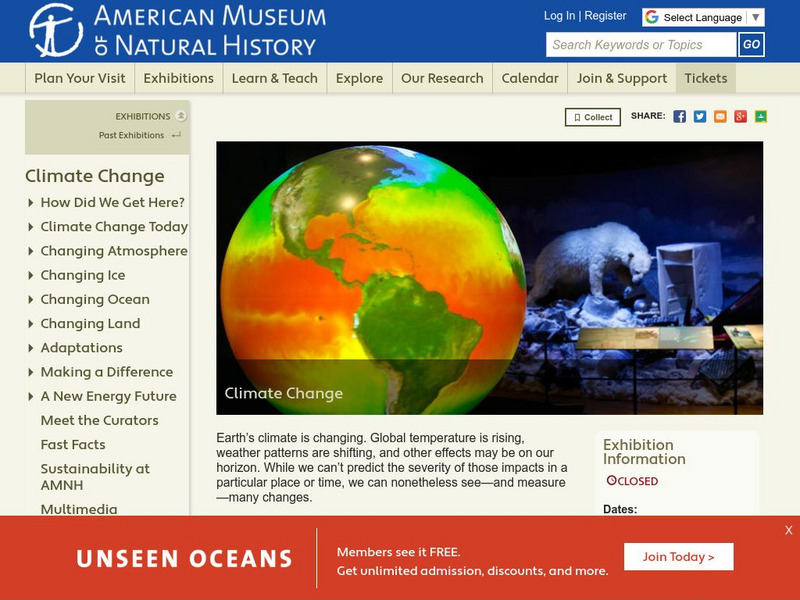American Museum of Natural History
American Museum of Natural History: If Trash Could Talk
What does your trash say about you? Take a close look inside your trash can and think about the clues it offers about your life.
American Museum of Natural History
American Museum of Natural History: Draw a Monarch Butterfly
Learn how to create a scientific illustration of a monarch butterfly in a few easy steps.
American Museum of Natural History
American Museum of Natural History: Create Your Own Time Capsule
By making time capsules, we can decide what message to send to the future about our own lives. If it were discovered years from now, what would the objects say about you and the time you lived in?
American Museum of Natural History
American Museum of Natural History: Optical Illusions and How They Work
What you see and what you think you see are different things. Find out what your brain doing behind-the-scenes!
American Museum of Natural History
American Museum of Natural History: See the Light
Take a look at light with these three easy experiments
American Museum of Natural History
American Museum of Natural History: Play With Color and Light
See what happens when you mix different colors of lights.
American Museum of Natural History
American Museum of Natural History: Trip Up Your Brain
Try this trippy experiment to fool your brain.
American Museum of Natural History
American Museum of Natural History: Crazy Camouflage
Create a flounder fish that's hard to spot. In this hands-on activity, students gather evidence to explore how camouflage helps animals survive.
American Museum of Natural History
American Museum of Natural History: What Is Water?
This comprehensive article provides information about the physical properties of water, the importance of water as an Earth material, the processes and cycles that water undergoes on Earth, its importance to life on Earth, and why we...
American Museum of Natural History
American Museum of Natural History: Grow Rock Candy
Students can carry out an investigation using sugar and water to determine whether heating or cooling a substance may cause changes that can be observed. This activity reinforces the ideas that the properties of materials can change when...
American Museum of Natural History
American Museum of Natural History: Find My Plankton Baby Picture
By observing photos of plankton at different life stages, students can obtain information that will allow them to construct evidence-based accounts of how parents and offspring don't always look alike.
American Museum of Natural History
American Museum of Natural History: Make Your Own Weather Station
Students can plan and carry out investigations of local weather patterns by building their own weather stations to collect observations of various weather conditions: rainfall, wind direction, and air pressure.
American Museum of Natural History
American Museum of Natural History: Map Your World
Students can follow these easy steps to develop a model (drawing) of their room and the things in it. Then they can broaden the drawing to include their entire floor, apartment, or house.
University of Florida
Florida Museum of Natural History: Kitchen Science
This guide focuses on everyday substances and how we can change their properties by adding heat or cold, physically manipulating them, or mixing them together.
University of Florida
Florida Museum of Natural History: Physical Science
This guide focuses on four physical science topics that fascinate children and scientists alike. They are motion, magnets, sound, and light. With your guidance and support, these topics provide children with many opportunities to explore...
University of Florida
Florida Museum of Natural History: Plant Life
This teacher's guide focuses on the fascinating world of plants. Through books and other print materials, and exploration of actual plants, children will identify plants as living things, examine the parts of plants, experiment with what...
University of Florida
Florida Museum of Natural History: Investigating Water
This guide engages children in the process of scientific inquiry using the context of a favorite early childhood pastime-water play.
University of Florida
Florida Museum of Natural History: Animals 1: Fur, Fins, Feathers, and More
This teacher's guide focuses on familiar animals such as mammals, birds, reptiles, amphibians, and fish.
American Museum of Natural History
American Museum of Natural History: Five Tools and Processes for Translating the Ngss Into Instruction and Classroom
The Five Tools and Processes for Translating the NGSS are designed to help professional development leaders work with teachers on curriculum, instruction, and assessment as they achieve this vision. Click the link for each tool for an...
University of Florida
Florida Museum of Natural History: My Body My Senses
This teacher's guide introduces children to the human body and the five senses and covers the major body parts and what they do. Children also will use their five senses to learn about the world.
American Museum of Natural History
American Museum of Natural History: O Logy: What's the Big Idea? Climate Change
What do people around the world need to do in order to slow the process of climate change? This resource dives into the dangers of change and proposes solutions.
American Museum of Natural History
American Museum of Natural History: Climate Change
A complete guide to the planet's climate change, including evidence, causes, effects, and conservation efforts.
Other
Swedish Museum of Natural History
This resource can be viewed in Swedish or English. Some informational links are in Swedish only.
Other
National Museum of Ireland
Visit the online home of the National Museum of Ireland in Dublin, Ireland. Browse through to research and discover historic sites, parks and gardens, culture and the arts throughout Ireland. Also provides links to its four other...









